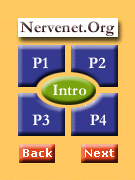




 |
 |
 |
 |
 |
|
|

|
|||
|
|
|||
|
Principal Investigator/Program Director Williams, Robert W. |
|||
| .Generic
resources versus specific goals The resources generated by this program project and the two scientific cores will be open to the entire research community for collaborative and independent analysis. The new bioinformatic tools that we are now in the process of testing will ultimately catalyze far more extensive research on the structure of the mouse CNS. Each of the first three projects, when viewed separately, is a major resource for virtually any type of neuroscience. Furthermore, the methods are generic in the sense that they can be applied to a wide range of systems and problems, both in research and in teaching. Our Neuroinformatics Program Project will allow us to combine brain maps with gene maps and thereby to explore the genetic basis of natural variation in CNS architecture—a topic that is now terra incognita. The mouse is the ideal mammal to exploit in developing these resources. We will address and answer a wide variety of questions: What genes control the size of the caudate nucleus? Why does one mouse have a large hippocampus relative to total brain size, whereas another has an unusually small hippocampus? What genes modulate the relative proportions of neurons and glial cells in neocortex, or the ratio of projection neurons and GABAergic interneurons in cerebellum or thalamus? The most innovative component of our system is that it will have a completely open structure offering unrestricted Internet access to all key raw data and even to the neurohistological collection itself. As a result, other neuroscientists will be able to independently use both the tissue and the genotypes. The web site and the Mouse Brain Library (MBL) already illustrate the main features of an open research workbench. Our distributed team of investigators has already demonstrated the ability and drive to collaborate in assembling the key resources required to implement the system. Only by combining efforts can scientists efficiently tackle the complex genetics of CNS structure. The amygdala, for example, has incredible structural complexity, and its architecture is undoubtedly variable among strains of mice. This structure may differ dramatically in mice such as Mus spicelegus, a colonial mound-building species from the Ukraine, and the standard commensal species Mus musculus domesticus. In assembling the MBL, we will produce highly detailed images of the amygdala for several thousand genetically defined mice, but we do not have the expertise or time to explore the genetic basis of anatomical and behavioral variation associated with the amygdala and many hundreds of other structures. This project will make the genotypes available along with powerful mapping tools in a "no strings attached" environment. We will not monitor or track who is using the collection, and we do not request coauthorship on papers that result from use of the resources. In the next decade, this program project should revolutionize quantitative neuroanatomy and stereology and give this field a broad quantitative genetic foundation. The scientists involved in this project are fully aware of the bioinformatics challenge of integrating four disparate, if complementary, groups, but we are committed to overcoming obstacles in delivering bioinformatics tools and resources to the neuroscience community. We hope that we succeed in conveying the excitement all of us feel about the whole program and about our individual projects. Although this is an ambitious project, we are confident that we can assemble these tools and resources in five years. Community-wide collaboration is familiar to geneticists who have used recombinant inbred (RI) strains in their research. A single genotype is replicated as an RI strain, and multiple individuals are phenotyped by many investigators. Data are accumulated on both phenotypes and genotypes. For example, John Belknap and colleagues have a database consisting of 400 behavior and neuropharmacological traits studied in the BXD/Ty set. Benjamin Taylor, Rosemary Elliott, and our own group maintain large databases on genotypes in RI strains. Mapping efforts in RI strains, however, suffer from some serious disadvantages. Even the largest RI panel, the BXD/Ty set mentioned above, consists of only 35 strains. RI strains currently have low statistical power and can be used only to map a major QTLs. This is one reason that we have pushed ahead with our advanced intercross. Not only will it complement the BXD set of strains, but it will significantly increase the statistical power to find and resolve QTLs |
|||
| Rationale | |||
| The External Advisory Board | |||
| Institutional Support for this Program Project | |||
| Conclusion | |||